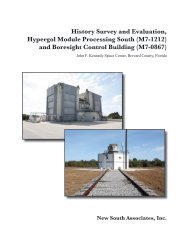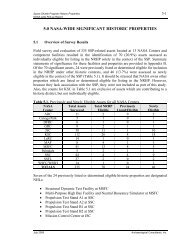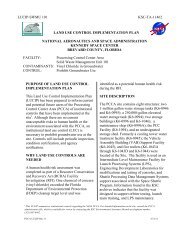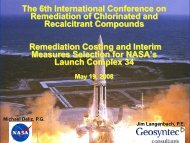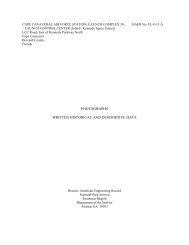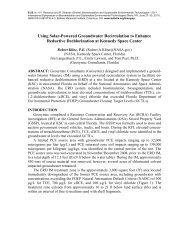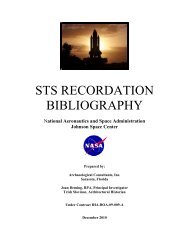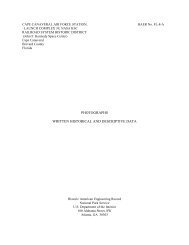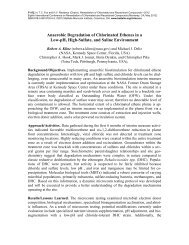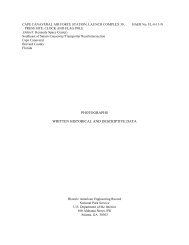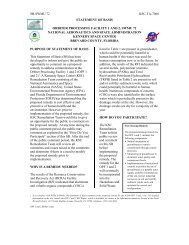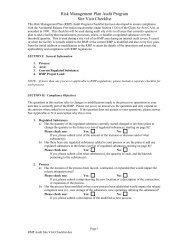john f. kennedy space center brevard county, florida - Environmental ...
john f. kennedy space center brevard county, florida - Environmental ...
john f. kennedy space center brevard county, florida - Environmental ...
Create successful ePaper yourself
Turn your PDF publications into a flip-book with our unique Google optimized e-Paper software.
At the 280-ft level is the ET gaseous oxygen vent arm and “beanie cap,” used to heat the liquid<br />
oxygen (LOX) vent system at the top of the ET to prevent ice formation. Around 2 minutes, 30<br />
seconds before launch, the “beanie cap” is raised, and 45 seconds later, the arm is retracted.<br />
However, it is not latched until SRB ignition, in case the launch needs to be held. The<br />
hammerhead crane at the top of the FSS measures approximately 95 ft in length, 10.5 ft in width,<br />
and 20 ft in height. It can be rotated through a full 360 degrees, and the hook can be positioned<br />
up to a maximum 85-ft radius. It has a 25-ton capacity through the 50-ft mark, and only a 10-ton<br />
capacity from the 50-ft mark to the 85-ft mark. The lighting mast measures 80 ft in height and<br />
has a 5-ft diameter; the support structure bridges above the hammerhead crane. At roughly 21 ft<br />
due south from the southeast corner of the FSS sits the hinge column for the RSS, which is<br />
supported by a triangular-footprint trussing system off of the south elevation of the FSS.<br />
The RSS has overall dimensions of approximately 160 ft in length, 59 ft in width and 189 ft in<br />
height. It contains the PCR, which provides protected access to the Orbiter’s cargo bay for the<br />
installation and servicing of payloads. The PCR itself has dimensions of 50 ft in length and width,<br />
and 130 ft in height, and functions as an airlock by maintaining the controlled environment<br />
required when payloads are inserted into or removed from the Orbiter. The PCR contains five<br />
platform levels, excluding the main floor level. The main floor sits at 136 ft above sea level, and<br />
the five platform levels are at 145 ft, 154 ft, 163 ft, 175 ft, and 187 ft above sea level. Within the<br />
PCR is the Payload Ground Handling Mechanism (PGHM), which is used to transfer the payload<br />
from the Payload Canister to the orbiter. Below the PCR, within the RSS, is an Auxiliary Power<br />
Subsystem (APS) access platform (at 112 ft) and an Auxiliary Power Unit (APU) access platform<br />
(at 125 ft). The RSS also contains the orbiter midbody umbilical unit, which allows access to the<br />
midfuselage area of the orbiter, and the hypergolic umbilical system, which carries fuel, oxidizer,<br />
helium, and nitrogen lines from the FSS to the orbiter maneuvering system (OMS) pods. At the<br />
outer end of the RSS, opposite the column hinge, are two rotary bridge truck drive assemblies,<br />
each with eight wheels. These assemblies provide the means for moving the RSS through a 120-<br />
degree angle, at a 160-ft radius.<br />
LP 39B also contains a Sound Suppression System. This system includes a 300,000-gallon<br />
capacity water tank that begins to release water just before main engine ignition. The water flows<br />
to six 12-ft high MLP nozzles called “rainbirds,” protecting the Orbiter and payloads from<br />
damage by acoustical energy reflected off of the MLP during liftoff. A peak flow rate of 900,000<br />
gallons per minute occurs approximately 9 seconds after liftoff.<br />
The resource boundary extends from the outer perimeter of the launch pad’s hardstand,<br />
approximately 10 feet, which includes all necessary structures and components historically<br />
required for its functions.<br />
SIGNIFICANCE: On January 21, 2000, Pad B (LP 39B; Facility No. J7-337) was listed in the<br />
NRHP as a contributing resource within the Launch Complex 39: Pad B Historic District in the<br />
context of the Apollo Program, ca. 1961 through 1975. LP 39B has since gained importance in<br />
the context of the Space Shuttle Program, circa 1969 to 2010. In addition to its contributions to<br />
the NRHP-listed historic district, LP 39B is considered individually eligible for listing in the<br />
NRHP under Criteria A and C in the areas of Space Exploration and Engineering, respectively.<br />
Because it has achieved significance within the past 50 years, Criteria Consideration G applies.<br />
The period of significance for the LP 39B is from 1985, when the pad received its first flightready<br />
Space Shuttle vehicle, through 2010, the designated end of the Space Shuttle Program. The<br />
Space Shuttle Program is the longest running American <strong>space</strong> program to date. Unlike the<br />
Mercury, Gemini and Apollo programs, the emphasis was on cost effectiveness and reusability, as<br />
well as the construction of a <strong>space</strong> station. This launch pad is one of two sites at NASA KSC



